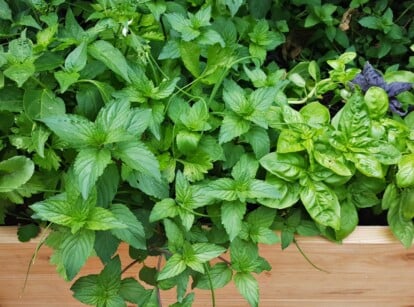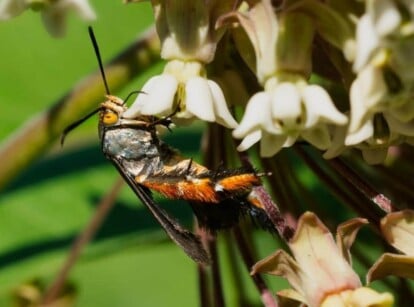How to Identify and Control Spruce Budworm
The spruce budworm is the most common pest of conifer tree species. Sustainability specialist Huan Song discusses these damaging larvae and how to manage them.

Contents
Spruce budworms are some of the most geographically spread and destructive insects in North America. If you have hiked or driven through forests that have large patches of brown evergreen trees, you probably have seen their impact.
However, because spruce budworms are native insects, they also play an important role in the ecosystem. According to the Michigan Department of Natural Resources, dead white spruce and fir trees (which the worms leave behind) are particularly suitable habitats for cavity-nesting birds, rabbits, weasels and other wildlife.
The management or control of this pest is typically done by the local forestry service across a large area of land. But if you find trees on your property affected, you can use the information below to better understand and address this issue on a smaller scale.
What is Spruce Budworm?

There are two species of spruce budworms native to North America, the eastern spruce budworm (Choristoneura fumiferana) and the western spruce budworm (Choristoneura orae).
Both species grow into small adult moths around half an inch long with orange and brown wings. Their larvae have a shiny dark head and a reddish-brown body with white or yellow spots.
Both eastern and western spruce budworms are univoltine moths which means there is one new generation per year.
Life Cycle

Like many other univoltine species, the adult moths will time their life cycle with that of their main food source.
Adults will emerge from their pupal stage starting in mid-June to mid-July. They are active in the late afternoons and evenings. Mature female moths will mate and lay a mass of 25-40 eggs on the underside of the host tree’s foliage. Larvae emerge around 10 days later.
Typically, these caterpillars will not feed immediately upon hatching. Instead, they will spin silky threads on the bark of trees to create a cocoon-like shelter or hibernacula to overwinter. The larvae emerge the following April to start attacking the foliage and the new buds of their host trees.
Inspect your trees in April through early May for small larvae and start treatments before they get to their most voracious period in June. The 5th and 6th instars of this insect will cause the most damage to trees in preparation for their pupal stage.
Common Habitats

The eastern and western spruce budworms have different geographical distributions in North America.
As their name indicates, the eastern spruce budworm is found east of the Rocky Mountains, particularly in the Acadian forest in Maine and the northern boreal forests near the Great Lakes. Eastern spruce budworm populations can severely defoliate balsam fir and white, red, and black spruce trees. They can also cause occasional damage to tamaracks, pines, and hemlocks.
The western spruce budworm is distributed widely across the western United States and Canada and can be found as far south as New Mexico and as far north as Alaska. In contrast to the eastern spruce budworm, western spruce budworm populations prefer Douglas fir, grand fir, white fir, corkbark fir, blue spruce, Engelmann spruce, and white spruce. Ornamental conifers used in landscape design such as the Norway spruce and Scotch pine are also susceptible.
Depending on the period of their life cycle, the spruce budworm is found on different parts of host trees.
Females lay eggs close to tree buds. Newly hatched larvae find a more sheltered spot on the tree growth such as near staminate (male) flowers, in bark crevices, or under bud scales. When they emerge in the spring, they will eat the buds and then migrate to the end of the twig. Their sheltered location may make control and management more difficult.
What do Spruce Budworms Eat?

Spruce budworm larvae feed on the buds and new growth of host trees. They bore into needles, buds, staminate flowers, and cones. During a heavy infestation, they may also feed on older needles.
The first signs of spruce budworm damage appear on the outer branches of a tree’s upper crown. As the larvae feed, they separate needles at the base and dangle them along spun threads, eventually turning branches brown and causing needles to drop.
Although it is unusual for spruce budworms to kill a healthy tree in one season, the loss of foliage and thinning will stunt the growth of healthy trees over time. Repeated infestations might eventually kill even a previously healthy tree.
The budworm has an outbreak cycle of every 30 to 40 years. Most recently, a severe outbreak of the eastern spruce budworm occurred in 2006 in Quebec, causing the defoliation of 3000 hectares of trees.
Outbreaks may last many years and are a major concern for the forest service. Scientists are concerned that the threat of the budworm could be exacerbated with warmer and more favorable climate conditions and an earlier start to their feeding season.
How to Get Rid of Spruce Budworms
Because both types of budworms are endemic to North America, they are well adapted to the environment and have natural control factors to keep their populations in check.
Budworms are often parasitized by several species of wasps and flies. Their numbers are also largely dependent on the weather over a few years. During severe outbreaks, you may want to use a combination of chemical and environmental controls to mitigate their spread.
Organic or Chemical Control

Bacillus thuringiensis var. kurstaki (Btk) is an effective biological control for moderate populations of spruce budworms and caterpillars as they emerge from their eggs. Once ingested by the larvae of the budworm, this bacteria will attack its digestive system and eventually kill it.
Btk is readily available online or at local garden supply stores and can be used to treat multiple pests. For forest landowners and homeowners with multiple affected trees such as columnar conifers, using Btk can be an adequate solution for small populations.
Applications of horticultural oil may smother eggs that it successfully coats. As it’s difficult to identify where the eggs are on a given tree, this is not a viable option for large-scale management.
Different states have different regulations regarding the use of chemical insecticides, especially in vulnerable watersheds and environmentally sensitive areas.
Check with your state and local forestry service regarding the proper handling of the insecticides and connect with licensed professionals who can perform these treatments.
Environmental Control

The forest service uses several environmental management techniques to control budworm outbreaks.
For example, a young balsam fir growing under a mature balsam fir or white spruce is more susceptible to infestations as larvae drop from the canopy. In this case, it might be best to remove overstory trees and replace them with non-host trees.
Another method involves thinning or reducing host tree density to preserve vigorous trees of a similar age and height. Usually, spruce and fir trees under 60 years of age are the most healthy.
Felling and thinning trees to reduce the size of stands and monitoring of large trees require special equipment and training. It’s best to consult your forest service or extension offices.
Preventing Spruce Budworms

The best way to prevent this budworm is to closely monitor your trees’ health and provide them with the best growing conditions. In late summer or early fall, evaluate the current year’s spruce budworm damage. If there are few remaining needles in the tree canopy, that tree might be severely stressed.
For homeowners who have a few white spruce or Douglas fir trees, start fertilizing your trees from spring through summer. Feeding the trees will improve their vigor and help strengthen their natural defense system, lowering the risk of defoliation.
Many pests, including spruce budworms, will attack weaker plants as easy targets. Keeping your trees healthy will allow them to thrive for years to come.
Frequently Asked Questions
How does spruce budworm spread?
Adult spruce budworms are moths that may travel some distances to lay eggs. They can also be transported up to ten miles by storms and winds.
How much damage is done annually by the spruce budworm?
The spruce budworm is endemic to forests in North America. In regular years, they cause some damage to trees but are not devastating. During outbreaks, which occur every 30-40 years, they severely defoliate trees and kill many over a few years.
What eats the spruce budworm?
Spruce budworms are a normal part of the forest ecosystem. Both their larvae and the adult moth provide food sources for parasitic wasps, parasitic flies, spiders, and birds.








